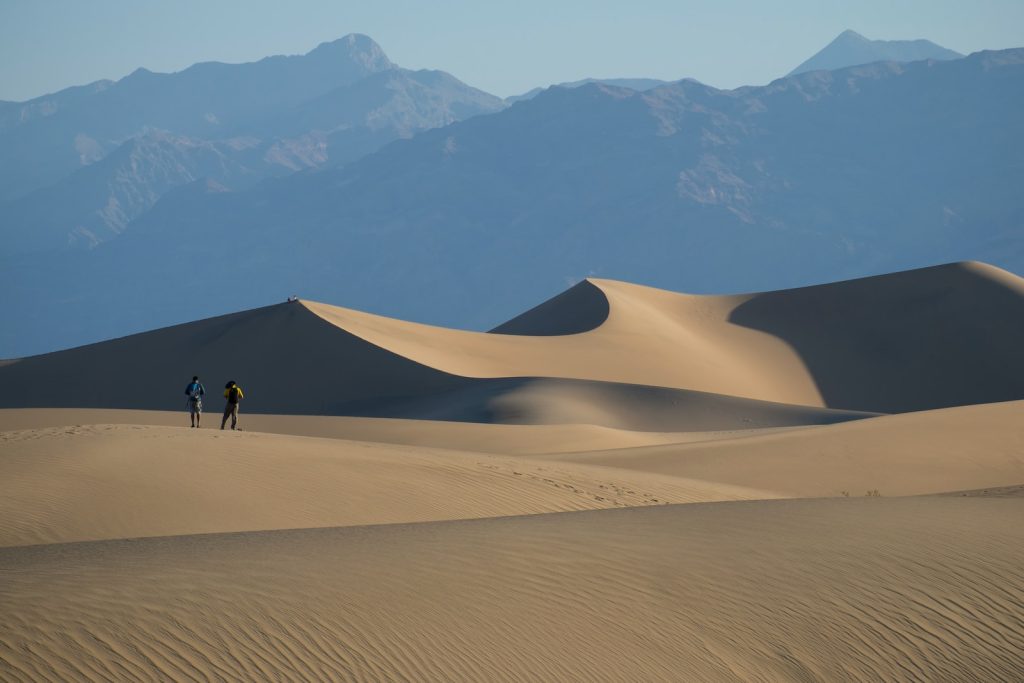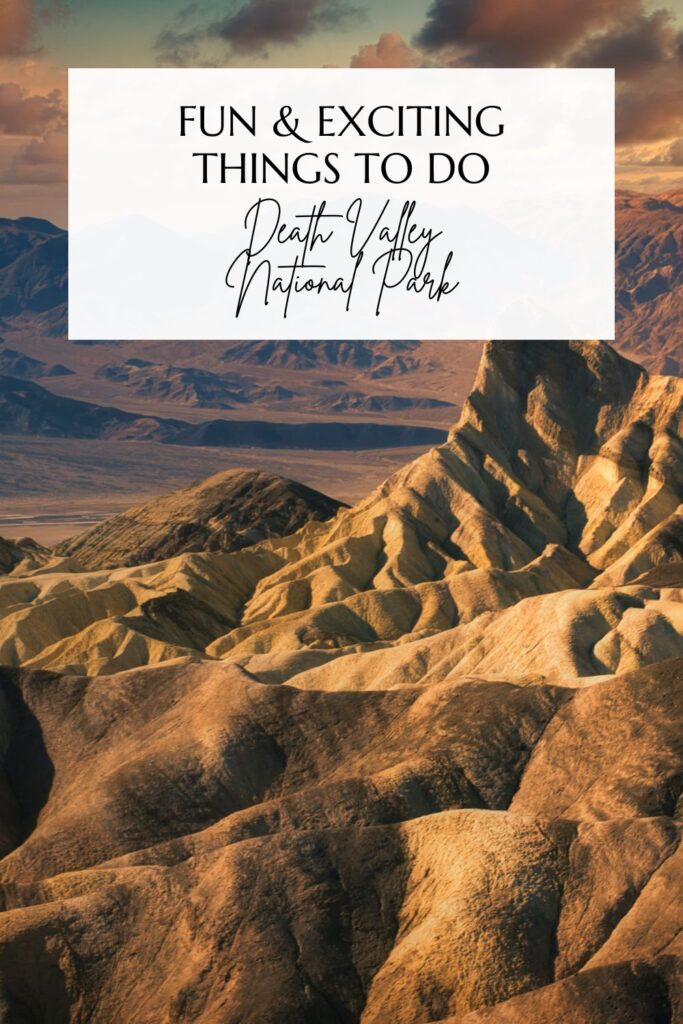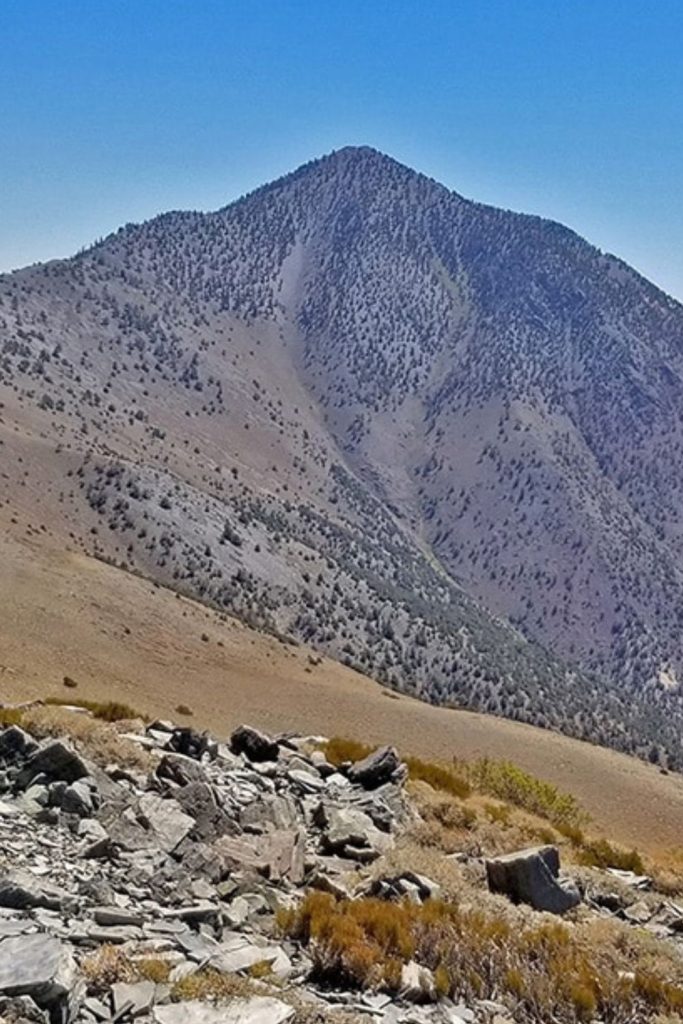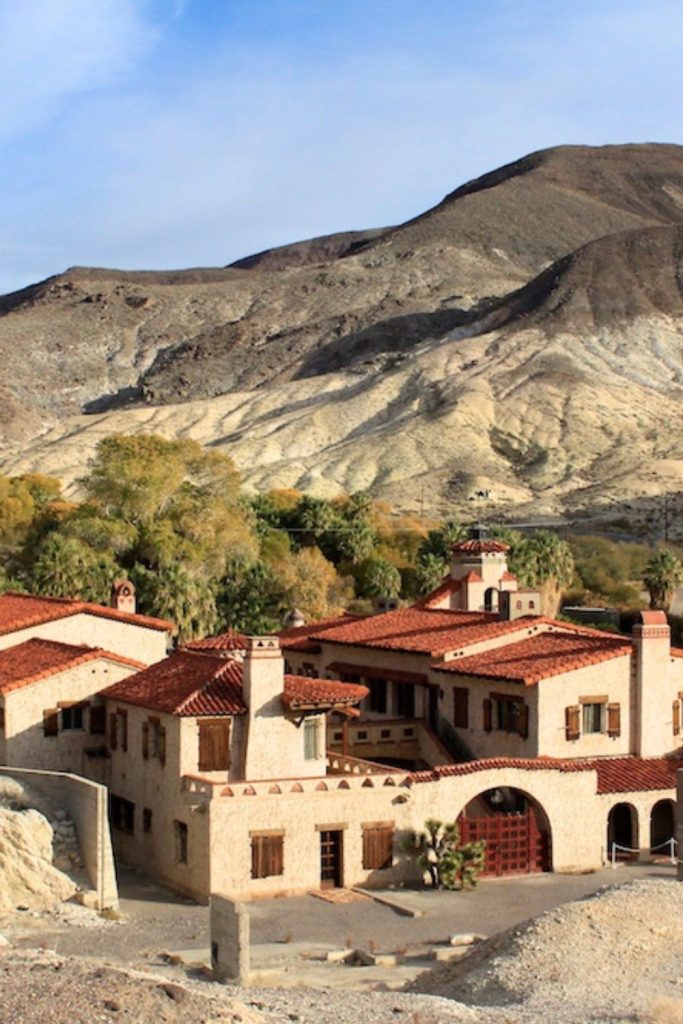
Fun and Exciting Things to Do Death Valley National Park
We may earn money or products from the companies mentioned in this post.
Located 100 miles west of Las Vegas astride the California/Nevada border, Death Valley National Park is the hottest and driest spot in North America. Just the name itself seems ominous. But, if you are ever in the area it is really worth a visit.

The vast empty expanses of this National Park located in the Mojave desert certainly aren’t lacking in natural beauty. Death Valley became part of the National Park System in the 1970s and is full of intriguing stories and beautiful scenery.
Climate
Temperatures in Death Valley can soar above 120 degrees in the summer. The extreme heat is due to Death Valley being the lowest spot in the United States at 282 feet below sea level. From November through April, the temperatures are fairly mild at about 60 or 70 degrees. To really take in the whole experience of Death Valley you should go while it is hot.
So, be brave and take a day trip in the summer, just make sure your car air conditioner is working properly and, bring plenty of water. Stay in designated tourist and hiking areas. Death Valley is not a place to get lost in the middle of the scorching summer months. Getting lost could be treacherous even in the spring as there is often little recognizable scenery to lead one back to the main monument.
Fauna

While parts of Death Valley are barren of life, this National Park does have a variety of animals that manage to make their home there; deer, gray fox, coyote, bobcat, badger, jackrabbit, desert tortoise, and an assortment of birds, bats, snakes, and lizards inhabit the foothills and desert flats. Desert bighorn sheep can often be seen in the cooler, higher elevations.
Things to Do in Death Valley National Park
Death Valley National Park, with its 3.3 million acres of desert, mountains, canyons, sand dunes, salt flats, and badlands, offers a variety of competitive and recreational outdoor activities, including grueling marathons and bicycle races, hiking, backpacking, and road biking.
Death Valley holds the record for the lowest, driest, and hottest location in North America. The vast area of California near its border with Nevada regularly posts summer temperatures of 120 degrees Fahrenheit and higher. The Badwater basin marks the continent’s lowest elevation at 282 feet below sea level, according to the National Park Service Death Valley website. Rainfall averages less than 2 inches per year.
The area’s climate generally stays sunny and dry throughout the year, but harsh winter storms can occur from November through March, according to the Park Service website.
Hiking
Death Valley hiking opportunities range from easy strolls along interpretative trails to strenuous backcountry treks. The Golden Canyon parking area provides access to a variety of easy and moderate hikes, including interpretative trails, walks into and through the Badwater basin salt flats, and the 4-mile Gower Gulch Loop that goes through canyons and past old borax mines.
Many strenuous hiking routes exist throughout the park including a short, steep climb up the Death Valley Buttes, a 3-mile walk into Little Bridge Canyon, and a 7-mile hike up Telescope Peak.
Backpacking
Even with the heat, it is amazing that this 2.2 million acre National Park is a backpacker’s paradise. Approximately 70 percent of the park is open to backpacking only 20 miles of it are developed trails, and 57 miles are left undeveloped.
Only the really experienced hiker should attempt any backpacking trips in Death Valley. Most of the park has been left to its natural beauty as not many people actually do brave the terrain. Telescope Peak (which is 11,049 feet), the highest spot in Death Valley is a good hike even in the summer because the higher elevation provides for cooler temperatures. The trail is seven miles one way with a 3,000-foot elevation change.

Another exciting hike is the trail leading from the lowest point in the U.S. Death Valley Monument up inside a crater of an extinct volcano. Remember to always bring at least a gallon of water a day if hiking. A back county permit is not necessary to hike Death Valley.
The lack of trails and a vast range of Death Valley National Park make it an ideal place for experienced backpackers to enjoy sweeping views, unique geology, and solitude for days at a time. Open washes, canyon bottoms, and abandoned dirt roads offer the best routes into the backcountry, according to the park website.
Park rangers ask overnight and longer-range backpackers to check in at the Furnace Creek Visitor Center or Stovepipe Wells Ranger Station to obtain a free backcountry permit and learn about the Leave No Trace guidelines for minimal-impact camping.
Bicycling
Death Valley National Park allows bicycles on hundreds of miles of roads that are open to traffic and on designed bike routes in developed areas. The National Park Service prohibits mountain bikes in wilderness areas. Bicyclists must ride single files on roads within the park.
Bike-riding routes range from the easy 1-mile paved trail between the Furnace Creek Visitors Center and the Harmony Borax Works to the more difficult 30-mile Greenwater Valley Road.
Road Races
The mid-July Badwater Ultramarathon has been called the world’s toughest foot race, according to the race website. As many as 90 top athletes cover 135 miles from Death Valley to Mt. Whitney, California–the highest peak in the contiguous United States at 14,505 feet in elevation.
The Death Valley Trail Marathon and 30K take place in December and limit the number of participants to 300. The 30K route takes runners along a gravel park road from Beatty, Nevada, through Titus Canyon, according to the race website.
Bike Race
The Furnace Creek 508 bicycle race in early October has become known as “the toughest 48 hours in sport,” according to the race website. The 508-mile route crosses 10 mountain passes on its way from Santa Clarita, California, through Death Valley National Park and on to Twenty-Nine Palms, California. Divisions include solo, two-person relays, and four-person relays.
The Castle
While in Death Valley do not miss touring the Castle. It seems strange that someone would build a castle in this hostile environment, thus the story behind it is quite interesting.
A man named Scotty was prospecting for gold in Death Valley in the late 1800s and was able to pull out quite a bit of the ore. He, of course, would flaunt his findings in the finest hotels and saloons of California and Nevada while spending his money.

Scotty needed investors to continue his prospecting, as the kind of mining that he needed to do would cost money. He was able to attract an investor from Chicago, an insurance magnate named Albert Johnson. Mr. Johnson gave Scotty thousands of dollars over the next several years to keep the mine running in hopes that a huge load would be found. But, due to a number of unfortunate happenings, Scotty was unable to pull any gold out of the mine for years. Mr. Johnson decided to come out and take a look at this gold mine in which he had invested great amounts of money. Strangely, Johnson loved Death Valley so much that he stayed nearly a month. He had been in poor health and the dry sunny climate of Death Valley was just what his body needed.
Over the next ten winters, Albert Johnson returned to Death Valley with his wife, Bessie. They decided they needed somewhere comfortable to stay during their winter visits. They built the Death Valley Ranch in the late 1920s which turned into a castle. The construction of the nine buildings occurred from 1921 to 1931. Albert Johnson used the water from the spring to generate hydroelectric power, using a water wheel. He also had refrigeration, indoor plumbing, and a solar heating system.
The Johnsons built the castle with every modern convenience of the time; from electricity to a tower with musical chimes. Towards the end of the Great Depression, the Johnsons moved from Chicago to Hollywood, which made their visits to the Castle more frequent. They brought friends and business acquaintances with them and the castle turned into a popular hotel and tourist attraction over the years.
The Johnsons died in the 1940s and willed the Castle to a charitable organization called the Gospel Foundation. The Foundation continued to run the Castle hotel and tours. In 1970, the Gospel Foundation sold the estate to the National Park Service, whose job it is to protect and preserve the Castle and Death Valley for present and future generations to enjoy.
Camping
Camping is available in Death Valley but is most enjoyable from November through April. You can camp in any location, provided you are at least five miles from developed areas, one mile from a maintained road, and one-quarter mile from water sources. Camping closer to water sources or springs keeps the wildlife away. Bring your own water. There are hotel accommodations and a restaurant in the park. There is a tour running that will take you to see the old mines and the interesting flora and fauna of the park.
Considerations
The National Park Service recommends checking with ranger stations or the visitor center about current conditions, weather forecasts, and water availability before starting any outdoor activity in Death Valley.
October through April represents the best hiking period in Death Valley. Rangers suggest avoiding hiking on salt flats or areas below sea level in the summer. High peaks offer a respite from the heat but can be snow-covered during the winter.
Park rangers recommend carrying at least 2 liters of water per person for short winter hikes and a gallon or more during warmer months or longer hikes. Death Valley has few natural water sources, but the Park Service website warns that any water taken from springs or runoff should be boiled or treated before drinking.
